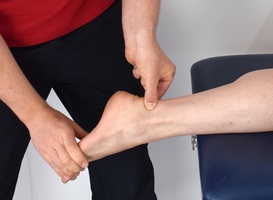To discover this, he will use an innovative ultrasound to make scans of 400 Achilles tendons that have never been damaged before. The people he will echo may be of all kinds: man, woman, old, young, fat, thin and of all nationalities, orientations, gender identities, and working in all corners of Erasmus MC. The most important condition: you must never have had any complaints from the Achilles tendon.
Schleswijk Visser is conducting the study together with sports doctor Robert-Jan de Vos. The ultimate goal of their study is to determine what the healthy Achilles tendon looks like: how long is it, how thick and what does the structure of the tendon look like? For example, are there differences between the Achilles tendons of a middle-aged man and a woman in her thirties? And are there differences between the Achilles tendons of people with a sedentary profession and people who walk and/or exercise a lot?
calf muscle
In order to study all this properly, the calf muscle strength of all participants is also measured. For example, it will be investigated what can be considered a normal, average calf strength and whether there is a possible relationship between calf muscle strength and Achilles tendon structure.
For the study, participants fill in a questionnaire (5 minutes of work) and visit the research room of Schleswijk Visser in the Erasmus MC. It makes an ultrasound of both Achilles tendons. Then participants do a few exercises that measure calf muscle strength. All in all, the survey takes 20 to 25 minutes.
Wound
Tendon disease (tendinopathy) is a literal Achilles heel for patients and caregivers. This is especially true for runners. “About half of runners will experience Achilles tendon problems at some point. Most often, overload is the cause, although it is not the only risk factor. About a third of patients who develop problems are inactive. There are other factors at play,” says Schleswig Fisherman. “Such an injury can be persistent, especially if the right treatment is not given, or if no or the wrong exercises are done. Then such an injury can last for 10 years.”
By: National Care Guide
–


